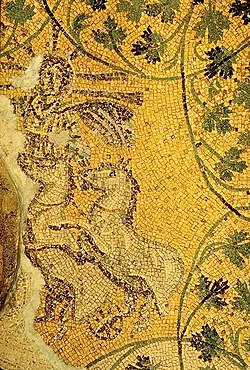| Revision as of 10:27, 17 December 2024 edit174.208.232.239 (talk) It’s actually Apollo I am an archeologist who works at the Vatican and all of my colleagues agree it’s Apollo. Literally look up a photo of Roman depictions of Apollo they look similar to Helios.Tags: Reverted Mobile edit Mobile web edit← Previous edit | Revision as of 17:34, 17 December 2024 edit undoAugmented Seventh (talk | contribs)Extended confirmed users13,225 edits Reverted 1 edit by 174.208.232.239 (talk): Needs sourceTags: Twinkle Undo Mobile edit Mobile web edit Advanced mobile editNext edit → | ||
| Line 13: | Line 13: | ||
| }} | }} | ||
| The popularly named "'''Tomb of the Julii'''" (Mausoleum "M") survives in the ] beneath ]. The serendipitous discovery near the ] has a vaulted ceiling bearing a ] depicting ] |
The popularly named "'''Tomb of the Julii'''" (Mausoleum "M") survives in the ] beneath ]. The serendipitous discovery near the ] has a vaulted ceiling bearing a ] depicting ] (Roman ]) with an ] riding in his chariot, within a framing of rinceaux of vine leaves. The mosaic is dated to the late 3rd century to early 4th century. Other mosaics in this tomb depicting Jonah and the whale, the good shepherd carrying a lamb (the '']'' motif), and fishermen have encouraged its interpretation as a Christian tomb. | ||
| This tomb was first discovered in 1574 AD when workmen accidentally broke through the ceiling while conducting some floor alterations in the basilica. The inside was briefly explored and documented before the opening was sealed over once more.<ref>The Bones of Saint Peter, John Evangelist Walsh 1982</ref> | This tomb was first discovered in 1574 AD when workmen accidentally broke through the ceiling while conducting some floor alterations in the basilica. The inside was briefly explored and documented before the opening was sealed over once more.<ref>The Bones of Saint Peter, John Evangelist Walsh 1982</ref> | ||
Revision as of 17:34, 17 December 2024
Part of the Vatican Necropolis| Tomb of the Julii | |
|---|---|
 Detail of the mosaic Detail of the mosaic | |
| Click on the map for a fullscreen view | |
| General information | |
| Location | Vatican City |
| Coordinates | 41°54′8″N 12°27′12″E / 41.90222°N 12.45333°E / 41.90222; 12.45333 |
The popularly named "Tomb of the Julii" (Mausoleum "M") survives in the Vatican Necropolis beneath St. Peter's Basilica. The serendipitous discovery near the crypt has a vaulted ceiling bearing a mosaic depicting Helios (Roman Sol Invictus) with an aureole riding in his chariot, within a framing of rinceaux of vine leaves. The mosaic is dated to the late 3rd century to early 4th century. Other mosaics in this tomb depicting Jonah and the whale, the good shepherd carrying a lamb (the kriophoros motif), and fishermen have encouraged its interpretation as a Christian tomb.
This tomb was first discovered in 1574 AD when workmen accidentally broke through the ceiling while conducting some floor alterations in the basilica. The inside was briefly explored and documented before the opening was sealed over once more.
See also
References
- Beckwith, John 1979. Early Christian and Byzantine Art (Yale University Press): 19
- Perler, Othmar 1953, Die Mosaiken der Juliergruft im Vatikan (Universitätsverlag): 34–36
- Walsh, John Evangelist. The Bones of Saint Peter (The Chaucer Press): 15
- Specific
- The Bones of Saint Peter, John Evangelist Walsh 1982
Further reading
- Weitzmann, Kurt, ed., Age of spirituality: late antique and early Christian art, third to seventh century, no. 467, 1979, Metropolitan Museum of Art, New York, ISBN 9780870991790